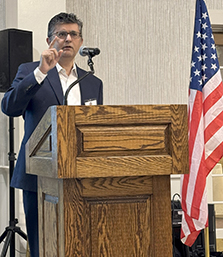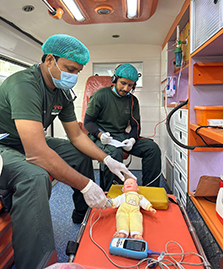Research in Karachi can help save lives across the globe
September/October 2025 | Volume 24 Number 5
 Photo courtesy of Dr. Junaid RazzakDr. Junaid Razzak
Photo courtesy of Dr. Junaid RazzakDr. Junaid Razzak
During the COVID-19 pandemic, the world witnessed the bravery of thousands of frontline health care workers who risked their lives responding to the urgent call for help. Yet not all health care professionals felt capable of answering that call.
“So when everybody's running away, what exactly makes you run towards the problem? That's what you want to study,” says Junaid Razzak, MD, professor and vice chair of research, Emergency Medicine, New York Presbyterian Weill Cornell Medicine. Though Razzak conducts much of his research in low- and middle- income countries (LMICs), his work has applications across the globe, including in the U.S.
Self-efficacy enhancement
Razzak’s iRise project, a study funded by Fogarty’s Mobile Health: Technology and Outcomes in LMICs (mHealth) program, assesses whether using an mHealth app to strengthen the self-efficacy of ER personnel increases their willingness to respond to a public health emergency. Razzak and his team are conducting this research in Karachi, Pakistan’s most populous city (with 20 million residents).
iRise is based on prior work by the team during the 2009-10 swine flu and other epidemics. This previous research showed that boosting, through a training intervention, people’s sense of control and ability to manage risks made it more likely that they would respond in a crisis. However, because the training intervention is conducted in-person and lasts several hours, it posed a challenge to busy Emergency Departments.
How could this model be improved? Razzak says, “When you’re in a crisis situation, you want to reach a lot of people where they are. The way to do that is to use telecommunications.”
Phase one of the study developed and pilot-tested an appropriate mHealth curriculum based on factors identified as being able to improve self-efficacy and willingness to respond. The app incorporates the Hospital-Based Infrastructure Training (H-BIT) program, which has been validated across multiple countries and contexts. The H-BIT program integrates scenario-based didactic content with individualized interactive activities relevant to willingness to respond, such as mapping out multiple routes to a health care professional’s worksite as part of disaster-response contingency planning.
“A mobile app means that our research can have global impact,” says Razzak. Following completion of the project’s phase one goals, the team is now planning a randomized controlled trial to see whether the mHealth intervention makes a difference on an individual level. Translation of research from a low income setting to a high income country such as the U.S. is all about first understanding a general principle, explains Razzak. If the principle works, then it can be implemented anywhere.
“Even when working exclusively within the U.S., local contexts vary a lot—for example, urban versus rural—so there’s always a need to customize and tailor the message a little bit,” says Razzak.
Dedicated leadership
Aga Khan University (AKU) is a research-led international university with campuses in Pakistan, East Africa and the United Kingdom. Its oldest campus is based in Karachi, a seaport and major commercial and industrial center located on the coast of the Arabian Sea. AKU--with physical campuses and programs in East Africa, in South Asia, Central America, Central Asia, parts of the Middle East and Europe--both resides in and focuses on the global south.
AKU is where Razzak launched his capacity building efforts centered on emergency medicine research. His attendance at a Fogarty discussion of investment in injury and trauma research inspired this work. “I was one of the youngest faculty members there—and very intimidated by all the wisdom in the room—but one thing that stood out was that injury is a huge problem globally.” Injury may be a problem for the local population, but it’s one that also affects travelers, he explains. The most common cause of death or injury among U.S. travelers is a road accident.
“We applied for a Fogarty grant (to build research capacity focusing on injury, trauma and disaster in LMIC settings) and we received the award soon after I moved back to Pakistan (from the U.S.) a year later,” says Razzak. With approval from AKU’s board, Razzak established an independent academic department of emergency medicine, the first in any university in the global south. “That single residency program became a model for the rest of the country and now there are over a dozen such programs across the nation,” says Razzak.
The AKU-based program continues to build research leadership at the PhD level with Fogarty investments. Overall, its impact has been “huge,” having changed the bedside care of patients coming to emergency departments in this fifth largest country in the world.
“It also has provided training opportunities for many U.S. PhDs and masters students,” says Razzak. Students from Johns Hopkins and Weill Cornell routinely spend time studying the model he developed to learn what they can implement in other places. “We’re trying to create a truly regional impact using the leadership built through this 20-year process, so we took the program to Afghanistan and subsequently to East Africa. So there's a South-South collaboration, and though the North still provides guidance and mentorship, it has an increasingly distant role in the process.”
 Photo courtesy of Dr. Junaid RazzakParamedics practice saving an infant's life using ambulance telemedicine
Photo courtesy of Dr. Junaid RazzakParamedics practice saving an infant's life using ambulance telemedicine
Prehospital systems
“When I ran an emergency medical service (EMS) in Karachi, one of the shocking numbers was how many children were dying in ambulances each day—anywhere from five to 25 or 30 children,” says Razzak. His FEAMER trial, supported by the Eunice Kennedy Shriver National Institute of Child Health and Human Development, addresses this issue directly.
His research team’s first step was to answer the question:
Why are so many children dying in ambulances? Prehospital transport times were not the problem, given that Karachi ambulances could reach their destinations in under an hour. Digging deeper into the data, the team discovered that a lot of the children who died were newborns.
“Many paramedics are uncomfortable dealing with small babies, because that's not an area where they've spent a lot of time training,” says Razzak. Of course, the same is not true of experienced pediatric emergency physicians. He thought,
What if we connect ambulances to physicians via video so they can jointly take care of really sick babies?
“There are two interesting things about illnesses among little children. First, they don’t complain and can't tell you what's going on, so it requires special training to be able to recognize a sick baby. The other thing is that once you start treating them, they respond right away—much better than adults.”
Before building out their video link, the researchers conducted focus group discussions and in-depth interviews among providers and parents to air any concerns. Everyone—parents, paramedics and physicians—thought it was a “no-brainer,” since any reduction in the time to recognize and treat illness would have great impact in a population of small children, says Razzak. “We knew the video quality would potentially hurt or help, so we went through this whole elaborate process of testing the quality until we were really comfortable with both the technology and the process.”
Currently the team is conducting a trial where half of the ambulances have what they call “ambulance-based telemedicine,” while the remainder do not. “We are recruiting 700 critically ill children and looking at the potential change in outcomes.” Razzak believes the study should be complete in a couple of months.
At a conference where he presented early outcomes of the trial, attendees told him how important this could be for rural America where transport times can last hours.
“If we can show no harm was done and help was provided, we will not have to do any additional studies for this to have direct application. I think it will become a standard of care, which will help thousands, if not millions of children worldwide.”
More information
Updated November 19, 2025
To view Adobe PDF files,
download current, free accessible plug-ins from Adobe's website.
Related Fogarty Programs
Related Global Health Research Topics